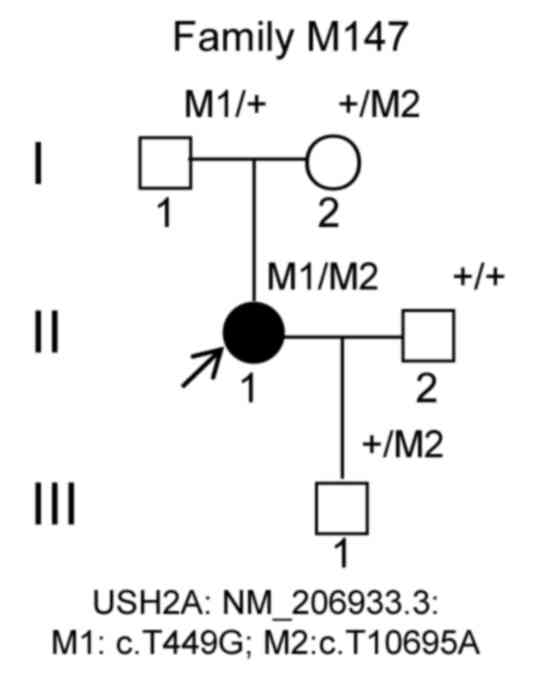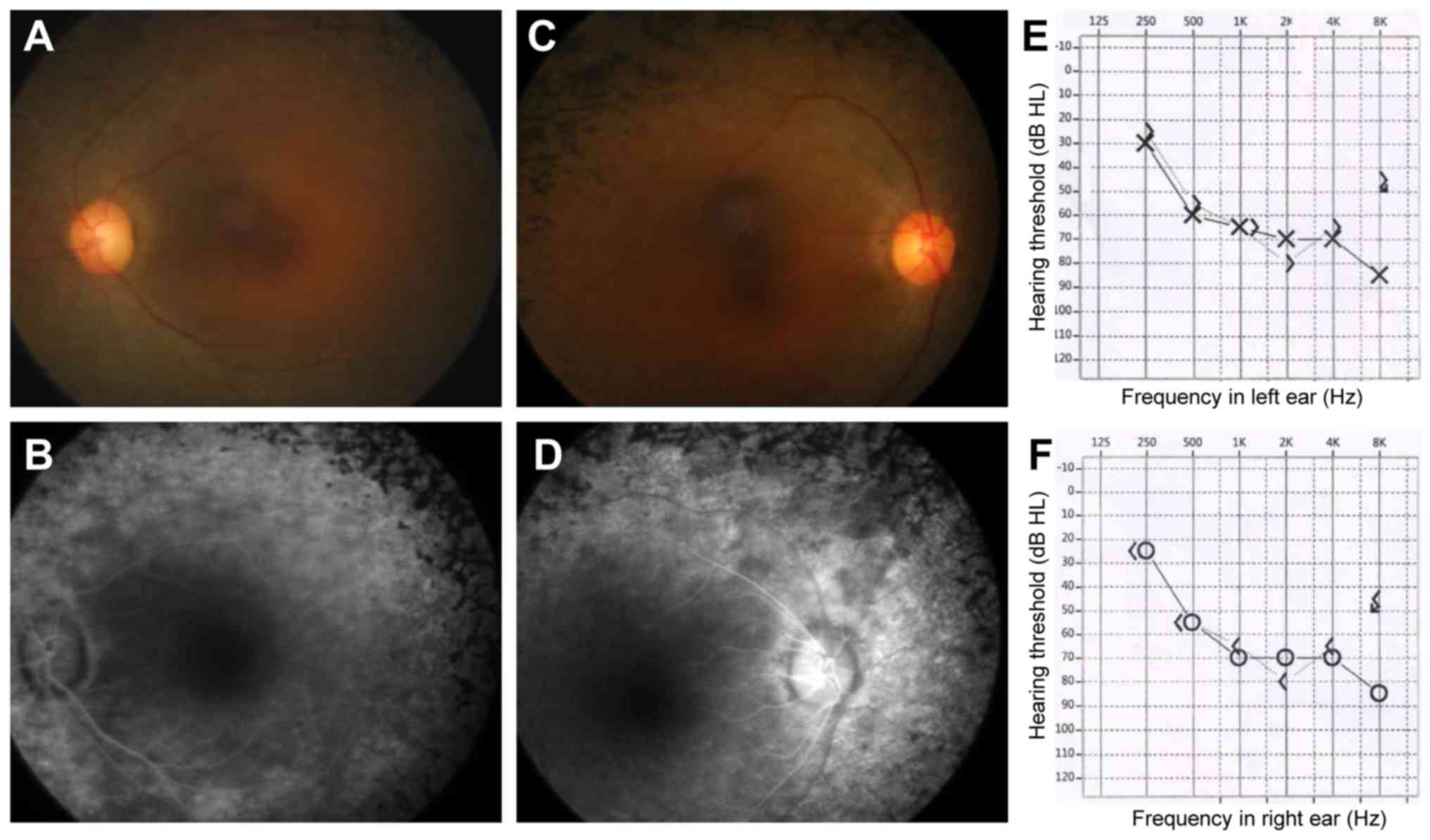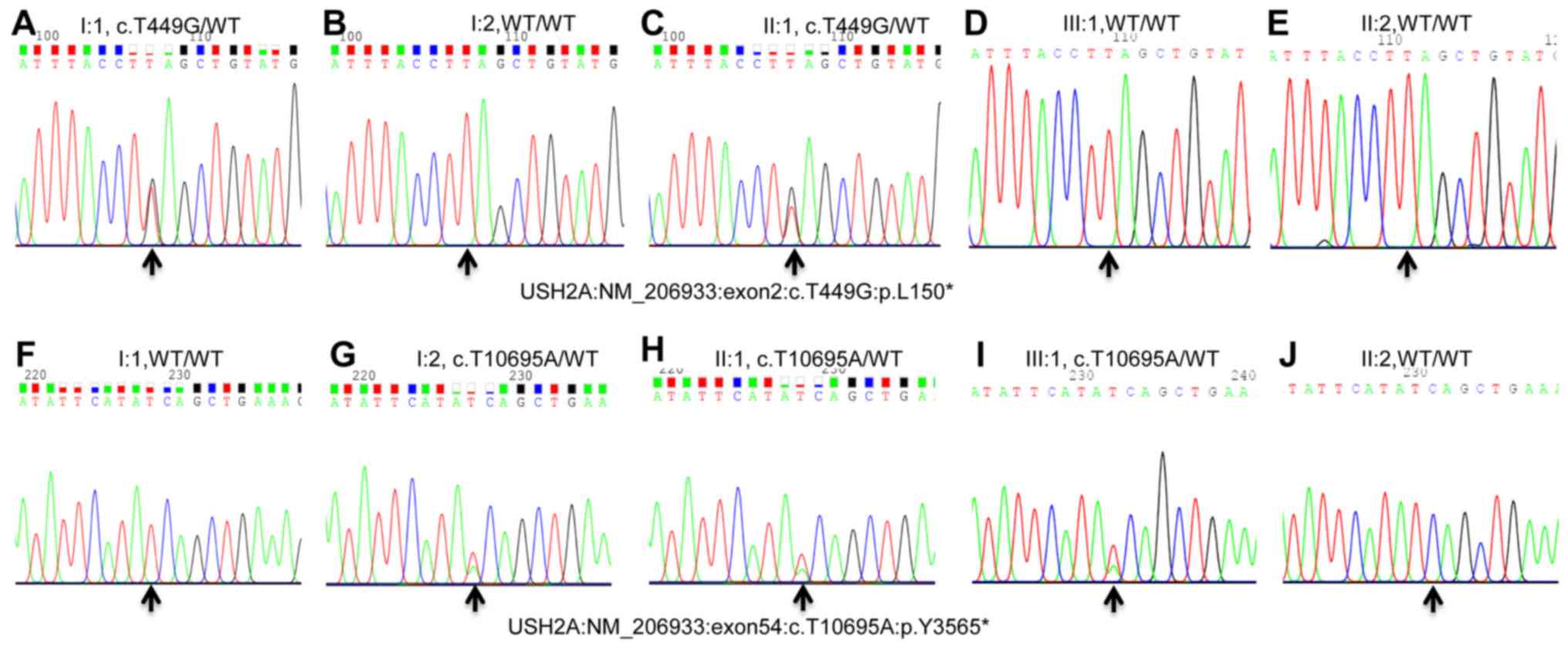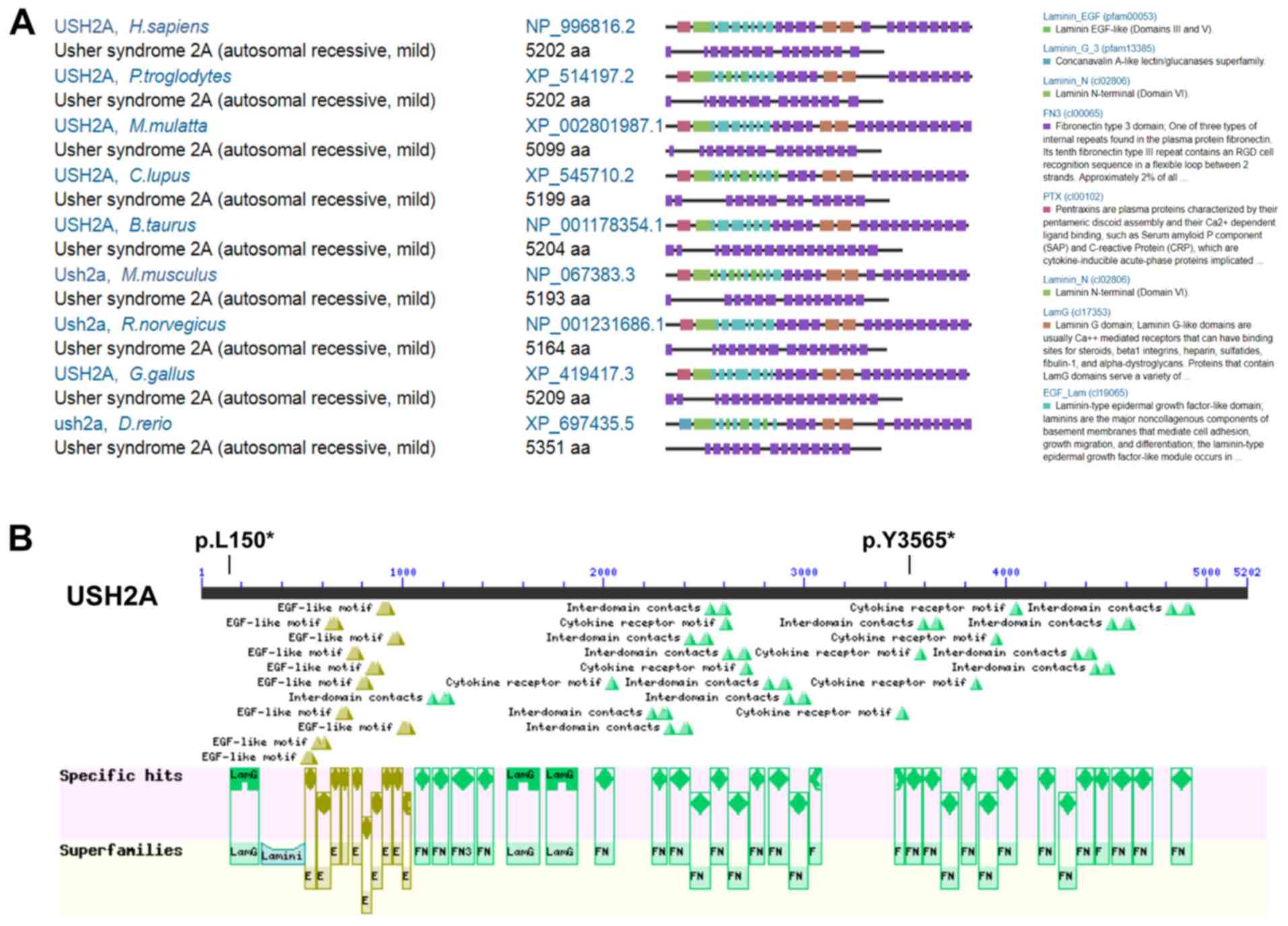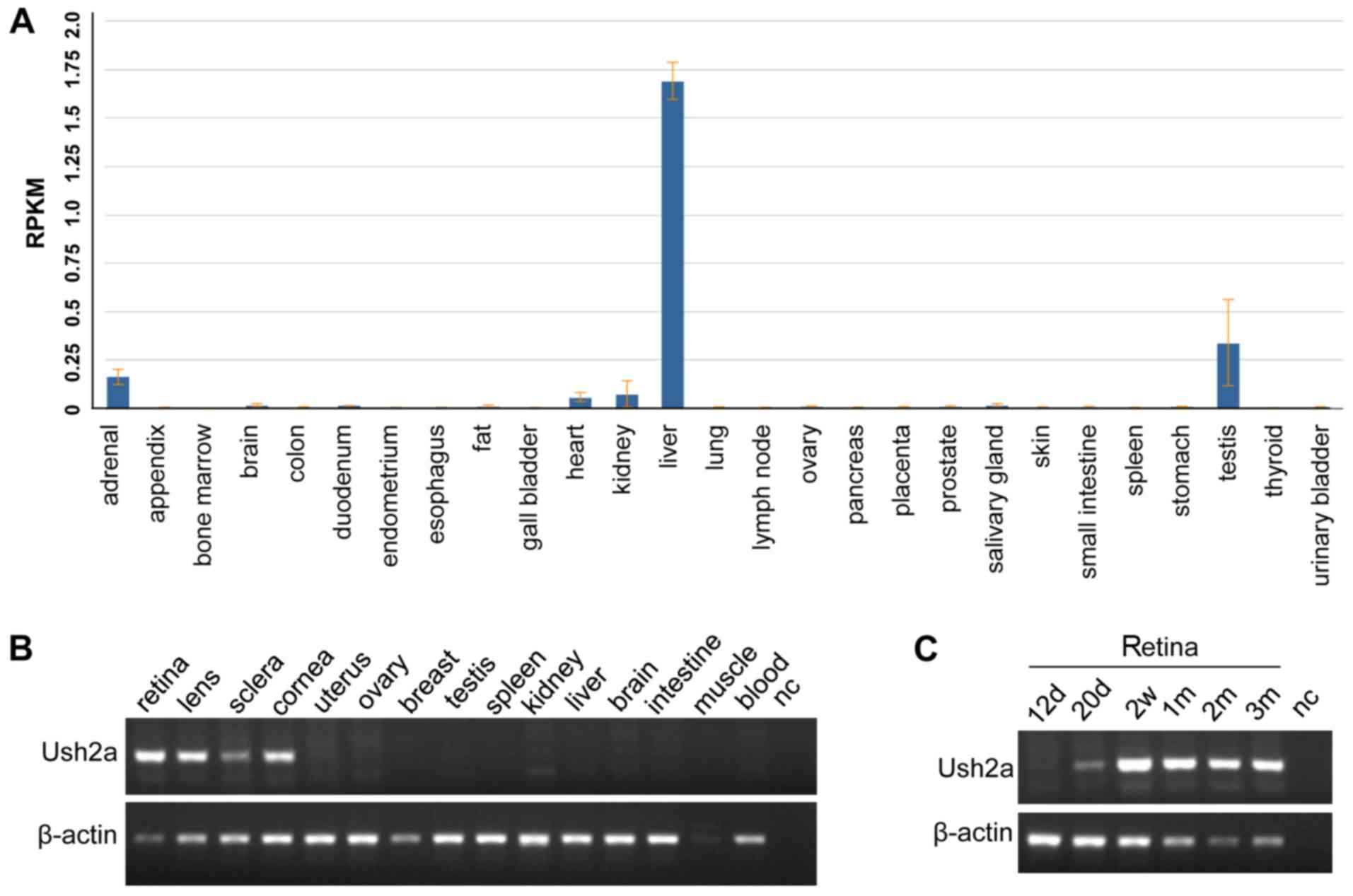|
1
|
Wei C, Yang L, Cheng J, Imani S, Fu S, Lv
H, Li Y, Chen R, Leung ELH and Fu J: A novel homozygous variant of
GPR98 causes Usher syndrome type IIC in a consanguineous Chinese
family by next generation sequencing. BMC Med Genet. 19:34642018.
View Article : Google Scholar
|
|
2
|
Mathur P and Yang J: Usher syndrome:
Hearing loss, retinal degeneration and associated abnormalities.
Biochim Biophys Acta. 1852:406–420. 2015. View Article : Google Scholar : PubMed/NCBI
|
|
3
|
Fu J, Shen S, Cheng J, Lv H and Fu J: A
case of Usher syndrome type IIA caused by a rare USH2A homozygous
frameshift variant with maternal uniparental disomy (UPD) in a
Chinese family. J Cell Mol Med. 24:7743–7750. 2020. View Article : Google Scholar
|
|
4
|
Zhu X, Li X, Tian W, Yang Y, Sun K, Li S
and Zhu X: Identification of novel USH2A mutations in patients with
autosomal recessive retinitis pigmentosa via targeted
nextgeneration sequencing. Mol Med Rep. 22:193–200. 2020.PubMed/NCBI
|
|
5
|
Eudy JD, Weston MD, Yao S, Hoover DM, Rehm
HL, Ma-Edmonds M, Yan D, Ahmad I, Cheng JJ, Ayuso C, et al:
Mutation of a gene encoding a protein with extracellular matrix
motifs in Usher syndrome type IIa. Science. 280:1753–1757. 1998.
View Article : Google Scholar : PubMed/NCBI
|
|
6
|
Besnard T, Vaché C, Baux D, Larrieu L,
Abadie C, Blanchet C, Odent S, Blanchet P, Calvas P, Hamel C, et
al: Non-USH2A mutations in USH2 patients. Hum Mutat. 33:504–510.
2012. View Article : Google Scholar : PubMed/NCBI
|
|
7
|
Ebermann I, Phillips JB, Liebau MC,
Koenekoop RK, Schermer B, Lopez I, Schäfer E, Roux AF, Dafinger C,
Bernd A, et al: PDZD7 is a modifier of retinal disease and a
contributor to digenic Usher syndrome. J Clin Invest.
120:1812–1823. 2010. View
Article : Google Scholar : PubMed/NCBI
|
|
8
|
Ebermann I, Scholl HP, Charbel Issa P,
Becirovic E, Lamprecht J, Jurklies B, Millán JM, Aller E, Mitter D
and Bolz H: A novel gene for Usher syndrome type 2: Mutations in
the long isoform of whirlin are associated with retinitis
pigmentosa and sensorineural hearing loss. Hum Genet. 121:203–211.
2007. View Article : Google Scholar : PubMed/NCBI
|
|
9
|
Hmani-Aifa M, Benzina Z, Zulfiqar F,
Dhouib H, Shahzadi A, Ghorbel A, Rebaï A, Söderkvist P, Riazuddin
S, Kimberling WJ and Ayadi H: Identification of two new mutations
in the GPR98 and the PDE6B genes segregating in a Tunisian family.
Eur J Hum Genet. 17:474–482. 2009. View Article : Google Scholar : PubMed/NCBI
|
|
10
|
van Wijk E, Pennings RJ, te Brinke H,
Claassen A, Yntema HG, Hoefsloot LH, Cremers FPM, Cremers CWRJ and
Kremer H: Identification of 51 novel exons of the Usher syndrome
type 2A (USH2A) gene that encode multiple conserved functional
domains and that are mutated in patients with Usher syndrome type
II. Am J Hum Genet. 74:738–744. 2004. View
Article : Google Scholar : PubMed/NCBI
|
|
11
|
Weston MD, Eudy JD, Fujita S, Yao S, Usami
S, Cremers C, Greenberg J, Ramesar R, Martini A, Moller C, et al:
Genomic structure and identification of novel mutations in usherin,
the gene responsible for Usher syndrome type IIa. Am J Hum Genet.
66:1199–1210. 2000. View
Article : Google Scholar : PubMed/NCBI
|
|
12
|
Adato A, Lefèvre G, Delprat B, Michel V,
Michalski N, Chardenoux S, Weil D, El-Amraoui A and Petit C:
Usherin, the defective protein in Usher syndrome type IIA, is
likely to be a component of interstereocilia ankle links in the
inner ear sensory cells. Hum Mol Genet. 14:3921–3932. 2005.
View Article : Google Scholar : PubMed/NCBI
|
|
13
|
Huang L, Mao Y, Yang J, Li Y, Li Y and
Yang Z: Mutation screening of the USH2A gene in retinitis
pigmentosa and USHER patients in a han Chinese population. Eye
(Lond). 32:1608–1614. 2018. View Article : Google Scholar : PubMed/NCBI
|
|
14
|
Zhang L, Cheng J, Zhou Q, Khan MA and Fu
J, Duan C, Sun S, Lv H and Fu J: Targeted next-generation
sequencing identified novel compound heterozygous variants in the
CDH23 gene causing Usher syndrome type ID in a Chinese patient.
Front Genet. 11:4222020. View Article : Google Scholar : PubMed/NCBI
|
|
15
|
Huang J, Fu J, Fu S, Yang L, Nie K, Duan
C, Cheng J, Li Y, Lv H, Chen R, et al: Diagnostic value of a
combination of next-generation sequencing, chorioretinal imaging
and metabolic analysis: Lessons from a consanguineous Chinese
family with gyrate atrophy of the choroid and retina stemming from
a novel OAT variant. Br J Ophthalmol. 103:428–435. 2019. View Article : Google Scholar : PubMed/NCBI
|
|
16
|
Fu J, Li L and Lu G: Relationship between
microdeletion on Y chromosome and patients with idiopathic
azoospermia and severe oligozoospermia in the Chinese. Chin Med J
(Engl). 115:72–75. 2002.PubMed/NCBI
|
|
17
|
Cheng J and Fu J, Zhou Q, Xiang X, Wei C,
Yang L, Fu S, Khan MA, Lv H and Fu J: A novel splicing mutation in
the PRPH2 gene causes autosomal dominant retinitis pigmentosa in a
Chinese pedigree. J Cell Mol Med. 23:3776–3780. 2019. View Article : Google Scholar : PubMed/NCBI
|
|
18
|
Wang F, Wang H, Tuan HF, Nguyen DH, Sun V,
Keser V, Bowne SJ, Sullivan LS, Luo H, Zhao L, et al: Next
generation sequencing-based molecular diagnosis of retinitis
pigmentosa: Identification of a novel genotype-phenotype
correlation and clinical refinements. Hum Genet. 133:331–345. 2014.
View Article : Google Scholar : PubMed/NCBI
|
|
19
|
Fu Q, Xu M, Chen X, Sheng X, Yuan Z, Liu
Y, Li H, Sun Z, Li H, Yang L, et al: CEP78 is mutated in a distinct
type of Usher syndrome. J Med Genet. 54:190–195. 2017. View Article : Google Scholar : PubMed/NCBI
|
|
20
|
Zhang Q, Xu M, Verriotto JD, Li Y, Wang H,
Gan L, Lam BL and Chen R: Next-generation sequencing-based
molecular diagnosis of 35 Hispanic retinitis pigmentosa probands.
Sci Rep. 6:327922016. View Article : Google Scholar : PubMed/NCBI
|
|
21
|
Koenekoop RK, Wang H, Majewski J, Wang X,
Lopez I, Ren H, Chen Y, Li Y, Fishman GA, Genead M, et al:
Mutations in NMNAT1 cause Leber congenital amaurosis and identify a
new disease pathway for retinal degeneration. Nat Genet.
44:1035–1039. 2012. View Article : Google Scholar : PubMed/NCBI
|
|
22
|
Cheng J, Peng J and Fu J, Khan MA, Tan P,
Wei C, Deng X, Chen H and Fu J: Identification of a novel germline
BRCA2 variant in a Chinese breast cancer family. J Cell Mol Med.
24:1676–1683. 2020. View Article : Google Scholar : PubMed/NCBI
|
|
23
|
Marchler-Bauer A, Bo Y, Han L, He J,
Lanczycki CJ, Lu S, Chitsaz F, Derbyshire MK, Geer RC, Gonzales NR,
et al: CDD/SPARCLE: Functional classification of proteins via
subfamily domain architectures. Nucleic Acids Res. 45:D200–D203.
2017. View Article : Google Scholar : PubMed/NCBI
|
|
24
|
Imani S, Ijaz I, Shasaltaneh MD, Fu S,
Cheng J and Fu J: Molecular genetics characterization and homology
modeling of the CHM gene mutation: A study on its association with
choroideremia. Mutat Res. 775:39–50. 2018. View Article : Google Scholar : PubMed/NCBI
|
|
25
|
Imani S, Cheng J, Fu J, Mobasher-Jannat A,
Wei C, Mohazzab-Torabi S, Jadidi K, Khosravi MH, Shasaltaneh MD,
Yang L, et al: Novel splicing variant c. 208+2T>C in BBS5
segregates with bardet-biedl syndrome in an Iranian family by
targeted exome sequencing. Biosci Rep. 39:BSR201815442019.
View Article : Google Scholar : PubMed/NCBI
|
|
26
|
Wei C, Xiao T, Cheng J and Fu J, Zhou Q,
Yang L, Lv H and Fu J: Novel compound heterozygous EYS variants may
be associated with arRP in a large Chinese pedigree. Biosci Rep.
40:BSR201934432020. View Article : Google Scholar : PubMed/NCBI
|
|
27
|
Fu J, Zhou B, Zhang L, Balaji KS, Wei C,
Liu X, Chen H, Peng J and Fu J: Expressions and significances of
the angiotensin-converting enzyme 2 gene, the receptor of
SARS-CoV-2 for COVID-19. Mol Biol Rep. 47:4383–4392. 2020.
View Article : Google Scholar : PubMed/NCBI
|
|
28
|
National Research Council (US) Committee
for the Update of the Guide for the Care and Use of Laboratory
Animals: Guide for the care and use of laboratory animals. 8th.
National Academies Press (US); Washington, DC: 2011
|
|
29
|
Fu J, Cheng J, Zhou Q, Wei C, Chen H, Lv H
and Fu J: A novel missense variant c.G644A (p.G215E) of the RPGR
gene in a Chinese family causes X-linked retinitis pigmentosa.
Biosci Rep. 39:BSR201922352019. View Article : Google Scholar : PubMed/NCBI
|
|
30
|
Yang L and Fu J, Cheng J, Wei C, Zhou Q,
Ijaz I, Lv H and Fu J: A novel variant of the FZD4 gene in a
Chinese family causes autosomal dominant familial exudative
vitreoretinopathy. Cell Physiol Biochem. 51:2445–2455. 2018.
View Article : Google Scholar : PubMed/NCBI
|
|
31
|
Liu X, Cheng J, Mei Z, Wei C, Khan MA,
Peng J and Fu J: SCAR marker for identification and discrimination
of specific medicinal lycium chinense miller from lycium species
from ramp-PCR RAPD fragments. 3 Biotech. 10:3342020. View Article : Google Scholar : PubMed/NCBI
|
|
32
|
Dreyer B, Tranebjaerg L, Rosenberg T,
Weston MD, Kimberling WJ and Nilssen O: Identification of novel
USH2A mutations: Implications for the structure of USH2A protein.
Eur J Hum Genet. 8:500–506. 2000. View Article : Google Scholar : PubMed/NCBI
|
|
33
|
Aller E, Jaijo T, Beneyto M, Nájera C,
Oltra S, Ayuso C, Baiget M, Carballo M, Antiñolo G, Valverde D, et
al: Identification of 14 novel mutations in the long isoform of
USH2A in Spanish patients with Usher syndrome type II. J Med Genet.
43:e552006. View Article : Google Scholar : PubMed/NCBI
|
|
34
|
Baux D, Larrieu L, Blanchet C, Hamel C,
Salah SB, Vielle A, Gilbert-Dussardier B, Holder M, Calvas P,
Philip N, et al: Molecular and in silico analyses of the
full-length isoform of usherin identify new pathogenic alleles in
Usher type II patients. Hum Mutat. 28:781–789. 2007. View Article : Google Scholar : PubMed/NCBI
|
|
35
|
Yan D, Ouyang X, Patterson DM, Du LL,
Jacobson SG and Liu XZ: Mutation analysis in the long isoform of
USH2A in American patients with Usher syndrome type II. J Hum
Genet. 54:732–738. 2009. View Article : Google Scholar : PubMed/NCBI
|
|
36
|
Testa F, Melillo P, Bonnet C, Marcelli V,
de Benedictis A, Colucci R, Gallo B, Kurtenbach A, Rossi S,
Marciano E, et al: Clinical presentation and disease course of
Usher syndrome because of mutations in Myo7a or Ush2a. Retina.
37:1581–1590. 2017. View Article : Google Scholar : PubMed/NCBI
|
|
37
|
Garcia-Garcia G, Aparisi MJ, Jaijo T,
Rodrigo R, Leon AM, Avila-Fernandez A, Blanco-Kelly F, Bernal S,
Navarro R, Diaz-Llopis M, et al: Mutational screening of the USH2A
gene in Spanish USH patients reveals 23 novel pathogenic mutations.
Orphanet J Rare Dis. 6:652011. View Article : Google Scholar : PubMed/NCBI
|
|
38
|
Ng TK, Tang W, Cao Y, Chen S, Zheng Y,
Xiao X and Chen H: Whole exome sequencing identifies novel USH2A
mutations and confirms Usher syndrome 2 diagnosis in Chinese
retinitis pigmentosa patients. Sci Rep. 9:56282019. View Article : Google Scholar : PubMed/NCBI
|
|
39
|
He C, Liu X, Zhong Z and Chen J: Mutation
screening of the USH2A gene reveals two novel pathogenic variants
in Chinese patients causing simplex usher syndrome 2. BMC
Ophthalmol. 20:702020. View Article : Google Scholar : PubMed/NCBI
|
|
40
|
Rivolta C, Berson EL and Dryja TP:
Paternal uniparental heterodisomy with partial isodisomy of
chromosome 1 in a patient with retinitis pigmentosa without hearing
loss and a missense mutation in the Usher syndrome type II gene
USH2A. Arch Ophthalmol. 120:1566–1571. 2002. View Article : Google Scholar : PubMed/NCBI
|
|
41
|
Zlotogora J: Parents of children with
autosomal recessive diseases are not always carriers of the
respective mutant alleles. Hum Genet. 114:521–526. 2004. View Article : Google Scholar : PubMed/NCBI
|
|
42
|
Fu YC, Chen N, Qiu ZL, Liu L and Shen J:
Compound pathogenic mutation in the USH2A gene in Chinese RP
families detected by whole-exome sequencing. Mol Med Rep.
18:5016–5022. 2018.PubMed/NCBI
|
|
43
|
Reiners J, van Wijk E, Märker T,
Zimmermann U, Jürgens K, te Brinke H, Overlack N, Roepman R,
Knipper M, Kremer H and Wolfrum U: Scaffold protein harmonin
(USH1C) provides molecular links between Usher syndrome type 1 and
type 2. Hum Mol Genet. 14:3933–3943. 2005. View Article : Google Scholar : PubMed/NCBI
|
|
44
|
Zou J, Chen Q, Almishaal A, Mathur PD,
Zheng T, Tian C, Zheng QY and Yang J: The roles of USH1 proteins
and PDZ domain-containing USH proteins in USH2 complex integrity in
cochlear hair cells. Hum Mol Genet. 26:624–636. 2017.PubMed/NCBI
|
|
45
|
Sorusch N, Bauß K, Plutniok J, Samanta A,
Knapp B, Nagel-Wolfrum K and Wolfrum U: Characterization of the
ternary Usher syndrome SANS/ush2a/whirlin protein complex. Hum Mol
Genet. 26:1157–1172. 2017.PubMed/NCBI
|
|
46
|
Pater JA, Green J, O'Rielly DD, Griffin A,
Squires J, Burt T, Fernandez S, Fernandez B, Houston J, Zhou J, et
al: Novel Usher syndrome pathogenic variants identified in cases
with hearing and vision loss. BMC Med Genet. 20:682019. View Article : Google Scholar : PubMed/NCBI
|
|
47
|
Huang D, Eudy JD, Uzvolgyi E, Davis JR,
Talmadge CB, Pretto D, Weston MD, Lehman JE, Zhou M, Seemayer TA,
et al: Identification of the mouse and rat orthologs of the gene
mutated in Usher syndrome type IIA and the cellular source of USH2A
mRNA in retina, a target tissue of the disease. Genomics.
80:195–203. 2002. View Article : Google Scholar : PubMed/NCBI
|
|
48
|
Fuster-García C, García-García G,
González-Romero E, Jaijo T, Sequedo MD, Ayuso C, Vázquez-Manrique
RP, Millán JM and Aller E: USH2A gene editing Using the CRISPR
system. Mol Ther Nucleic Acids. 8:529–541. 2017. View Article : Google Scholar : PubMed/NCBI
|
|
49
|
Fuster-García C, García-García G, Jaijo T,
Fornés N, Ayuso C, Fernández-Burriel M, Sánchez-De la Morena A,
Aller E and Millán JM: High-throughput sequencing for the molecular
diagnosis of Usher syndrome reveals 42 novel mutations and
consolidates CEP250 as Usher-like disease causative. Sci Rep.
8:171132018. View Article : Google Scholar : PubMed/NCBI
|
|
50
|
Adams DR and Eng CM: Next-generation
sequencing to diagnose suspected genetic disorders. N Engl J Med.
379:1353–1362. 2018. View Article : Google Scholar : PubMed/NCBI
|















